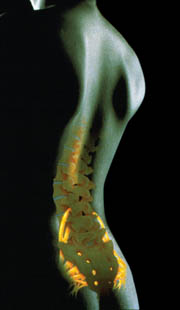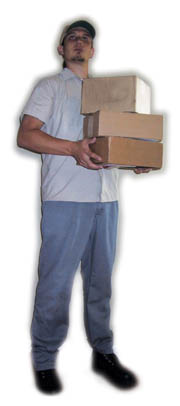Ergonomics is a branch of bio-mechanical engineering science applied to fit the workplace conditions and physical job demands to the biostructural capabilities and limitations of the worker, including all aspects of the worker's physical specifications, physiological behavior patterns, sociological attributes, repetitive labor effects, task organization, load duration, range of motion, material/equipment layout, coworker interaction, and gross environmental stress criteria. It's a relatively new field, with a lot of impure science, peculiar data variations and unsubstantiated findings.
Originating in 1949 during World War II, it endeavored to overcome the mechanical and performance failures of pilots due to human error, physical strain and fatigue encountered under wartime stress. Back then there was a war to be won and performing the best was the way to win it. Today, there are more than a few debates and arguments between our elected officials, scientists, labor unions and lawmakers when it comes to matching regulatory standards to scientific theory and safe, feasible
work practices. As is sometimes the case with OSHA, a law regulating the quality of work-life may dictate certain acts or conditions in precedence to the scientific analysis that explains the nature of that same act or condition. If a law mandates that the employer shall either provide a safety device not yet in existence for his employee's protection or else remove his employees from harm's way (off the work site) then we have not solved a specific dilemma as much as created another entirely new problem. The fact remains that every day in this country, workers are being seriously injured and the economy debilitated due to poor ergonomic practices. Doing nothing about it is hardly an option.

The statistics
The number-one worker's compensation claim category in the nation is Work Related Musculoskeletal Disorder Syndrome. While soft tissue and joint injuries may not be killing us on the job in the same numbers as falls from heights or electrocution, they are still affecting our national economy in very big ways. Claims to our employer's insurance, lost work time, reduced productivity and extended medical leaves associated with surgery, therapy and recovery all combine to rob us of sales, salaries and services. Soft tissue and joint injuries don't present much hard evidence, and are often difficult to clinically diagnose and, therefore, treat.Experienced occupational physicians have become more skilled at deducing the source of the patient's pain, discomfort and physical limitations from the work environment rather than their symptoms. Regrettably, the solution to the injured worker's condition is seldom solved by surgery. The costs of these claims is rising annually but their success rate is relatively poor and only a few workers appear to return to 100 percent or their original physical capacity.
During coffee break, listen for at least one worker complain about the pain in his back, shoulder, neck or wrist. I often ask my trainees if they think their great grandfathers and grandmothers ever suffered from repetitive motion disorder or carpal tunnel syndrome. Most agree they might have had some complaints back then but hardly called them "disorders" or "syndromes." As a matter of fact, they'd often take the name of their occupation and attach a descriptive term to it, such as: logger's hitch (limp); lineman's crick (neck vertebrae); miner's choke (coal dust); and welder's fever (intoxification). They were more accepting of their adverse working conditions in 1850 out of ignorance of the science as well as by temperament. Their work places were without governing regulations and they were certainly less litigious.
Some of today's law firms actually specialize solely in work-related injuries and illnesses and are more inclined to offer their blue-collar clients a "pay-if-we-win" plan after construction injury settlements cleared six figures. Fueled by the insistence of the insurance industry, Congress has struggled with the workplace ergonomic issue in committee hearings for almost a decade.
The science of ergonomics is based on the employer's capability to change the workplace to fit the worker rather than the worker being adapted to his environment. Besides the hard sciences, most ergonomists agree that underlying all ergonomic study is a careful analysis of human emotional and psychological health; what sort of demands are the employer, the job and society putting on the worker, and how can the workplace be reorganized in a "humancentric" design.
Let's face facts: Construction sites do not lend themselves to these warm and fuzzy adaptations for the welder, laborer, plumber, carpenter, roofer, painter or drywaller. A multi-employer building site is in a state of constant change from mobilization, demolition, renovation, new construction and demobilization. Equipment is being off-loaded and re-loaded. Materials are delivered, laid out and consumed. All the time, waste materials are accruing and being disposed. Often, the site changes drastically from hour to hour, prohibiting the practical installation of any sort of device or work practice that could substantially address poor ergonomic practices. If it's not infeasible to implement some ergonomic-based construction aides then it might cause a hazard greater than the one we're being protected from. Besides, how many contractors could even afford to conduct a pre-job, site-specific ergonomic safety analysis, let alone perform the task-specific R&D that would be required to invent practical temporary ergonomic solutions on every job?
Every construction contractor I've audited has had at least one WRMDS claim every year he's been in business. In some cases, depending on his primary occupation, it was as high as 60 percent of total claims and cost as much as 90 cents on the insurance premium dollar.

The spine as a tool
The spine is a multi-purpose tool:• It forms the central vertical axis of the skeleton.
• It supports the head and provides it some shock absorption.
• It carries and balances our body despite an unwieldy weight-to-height ratio over our mobile biped frame.
• It allows for an extensive range of torso flexion.
• It protects the spinal cord and permits distribution of spinal nerves.
• It anchors more than 30 different muscles and organs.
Low back pain is the number-one cause of WRMDS claims in the nation, accounting for almost 30 percent of worker's comp payments. There are approximately 4,600 disabling back injuries in construction work each year costing contractor's more than $18 billion annually in insurance payments. The direct medical costs to treat these back injuries alone have risen more than 300 percent in 10 years. Back injuries also account for 25 percent of all the lost-time injuries in mining and construction industries, and occur primarily to male workers between the ages of 30 to 45 years.
There are 206 bones in the human body. The spine consists of 33 vertebrae in five distinct regions. Above the sacral, there are five lumbar vertebrae (L1 through 5) and each one consists of a structural body with a bony circular canal (pedicle) to protect the spinal column. One can actually feel the two bony plates (lamina) where they meet the pedicle at the spinous process to enclose the neural canal. The point where the lamina and the pedicle meet is the transverse process. The joint between the vertebrae is filled with a disk-shaped pad of fibrous cartilage with a jelly-like core, which is bound between opposing vertebrae by two long ligaments and various vertebral muscle groups. It's these that we often sprain and strain while carrying 10 gallons of joint compound upstairs.
The vertebral discs are designed to stabilize the entire vertebral column; allow for spinal flexion and torsion movements; and absorb shocks transferred to it from the skeleton.
The spine is not completely vertical but naturally S-shaped, which makes it 16 times stronger, for example, than a solid, vertical column of bones. The spine is distorted whenever we improperly lean forward and lift, twist or reach. This condition is exasperated when we add more weight to our lift or extend to greater distances away from the spine (crane-lift). The lumbar region has the fewest (but largest) vertebrae, the lowest degree of flexion and the greatest lateral curvature that fortunately allows us to lift heavy objects.
The lumbar region is most often injured whenever we:
• Carry excessive gut weight adding mass in the wrong direction and weakening our abdominal muscles.
• Practice crane-lifting techniques.
• Carry excessive dead-weight loads.
• Carry loads far away from the body.
• Rapidly twist, or lash our spine during a fall.
Lumbar ergonomics
There are many basic preventative measures a worker can take to prevent or minimize low back (lumbar) injuries. If we practice these safe lifting and working principles we can take back the control over our back health.Minimize the need to move heavy materials or equipment manually. Break the load down into smaller, easier to carry sizes.
Ask the following questions before you lift a load:
• Can I lift this load alone without injury?
• Do I need to use some mechanical advantage?
• Is it too awkward for one person to handle safely?
• Should I ask a coworker for help?
Plan your lift. Your back is not built like a crane and should not be asked to boom up, boom down and boom to the side.
Also:
1. Examine the load: Look the item over carefully for any grease, oil, slippery surfaces, sharp edges, loose parts and other hazards.
2. Know your load limit and cut it in half. Estimate the weight of the load. Divide it whenever possible or get help if it is more than you can comfortably lift alone.
3. Plan your route and make sure it is free of any obstacles that could cause you to trip or twist unnecessarily.
4. Avoid lifting loads from below knee level or above shoulder level and which require reaching out more than 15 inches, all of which may potentially damage lumbar disks.
5. Utilize safe lift practices:
• Stand close to the load and spread your feet to shoulder width with one foot slightly ahead of the other.
• Do not twist your body in any way to get into positions. This indicates the load should be broken down or shared with another worker.
• Squat down and tuck in your chin, keeping your back as straight as possible.
• Grasp the load firmly.
• Lift with your legs by slowly straightening them at the knee, back straight and vertical.
• Lift on the inhalation.
• Turn only with your feet. Do not twist at the waist or neck.

Why not ergonomic?
We can send a highly technical, 5-ton NASA instrument on an eight-year journey through the vacuum of space to a place no one has ever been, to photograph, research and report back on Jupiter's mysteries, but we still can't seem to keep our back straight while lifting 42 pounds.There are thousands of books detailing the subject of ergonomics. I can pick up any of a dozen equipment catalogs and order hundreds of ergonomically correct tools and aids. Occupational health physicians have recently earned their own heading in the Yellow Pages. But the capital costs potentially involved in adapting each construction site to ergonomic requirements of the workforce would prove prohibitive to most contractors. True to form, my best advice is to take it in "small bites." Perform a few random "job ergonomic analyses" to become aware of just how workers are using and abusing their bodies during the workday. Take the time to research a few low cost changes in work practices or equipment to save from those costly comp claims. Simply offering 10 paid minutes of stretching for the entire crew before each shift may be the best investment one can make for corporate safety, health and profitability.

Report Abusive Comment